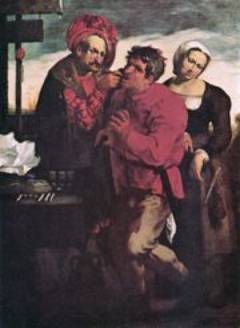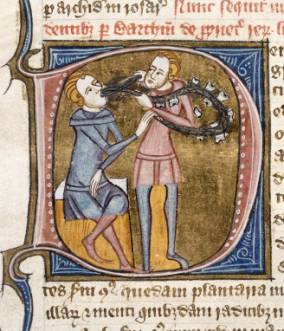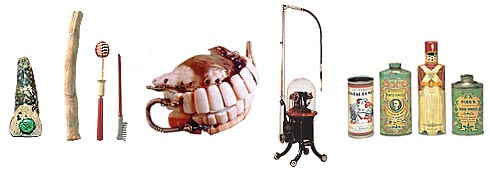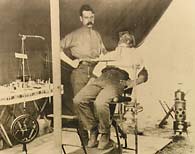

Farmer at the dentist, Johann Liss, c. 1616 Medieval dentist extracting a tooth. London; c. 1360-75

Dentistry has evolved from a simple toothpick to today's state-of-the-art technology.
Where Dentistry Started
The Indus Valley Civilization in Pakistan has yielded evidence of dentistry being practiced as far back as 7000 BCEThis earliest form of dentistry involved curing tooth related disorders with bow drills operated, perhaps, by skilled bead craftsmen. The reconstruction of this ancient form of dentistry showed that the methods used were reliable and effective.
A Sumerian text from 5000 BC describes a "tooth worm" as the cause of dental caries. Evidence of this belief has also been found in ancient India, Egypt, Japan, and China. The legend of the worm is also found in the writings of Homer, and as late as the 1300s AD the surgeon Guy de Chauliac still promoted the belief that worms cause tooth decay.
The Edwin Smith Papyrus, written in the 17th century BC but which may reflect previous manuscripts from as early as 3000 BC, includes the treatment of several dental ailments.In the 18th century BC, the Code of Hammurabi referenced dental extraction twice as it related to punishment.Examination of the remains of some ancient Egyptians and Greco-Romans reveals early attempts at dental prosthetics and surgery
Ancient Greek scholars Hippocrates and Aristotle wrote about dentistry, including the eruption pattern of teeth, treating decayed teeth and gum disease, extracting teeth with forceps, and using wires to stabilize loose teeth and fractured jaws. The first use of dental appliances or bridges comes from the Etruscans from as early as 700 BC. Roman medical writer Cornelius Celsus wrote extensively of oral diseases as well as dental treatments such as narcotic-containing emollients and astringents.
Historically, dental extractions have been used to treat a variety of illnesses. During the Middle Ages and throughout the 19th century, dentistry was not a profession in itself, and often dental procedures were performed by barbers or general physicians. Barbers usually limited their practice to extracting teeth which alleviated pain and associated chronic tooth infection. Instruments used for dental extractions date back several centuries. In the 14th century, Guy de Chauliac invented the dental pelican (resembling a pelican's beak) which was used up until the late 18th century. The pelican was replaced by the dental key which, in turn, was replaced by modern forceps in the 20th century.[citation needed]
The first book focused solely on dentistry was the "Artzney Buchlein" in 1530, and the first dental textbook written in English was called "Operator for the Teeth" by Charles Allen in 1685. It was between 1650 and 1800 that the science of modern dentistry developed. It is said that the 17th century French physician Pierre Fauchard started dentistry science as we know it today, and he has been named "the father of modern dentistry". Among many of his developments were the extensive use of dental prosthesis, the introduction of dental fillings as a treatment for dental caries and the statement that sugar derivate acids such as tartaric acid are responsible for dental decay.
Ancient Origins
 |
Toothbrush fashioned from a tree branch |
5000 BC—A Sumerian text of this date describes “tooth worms” as the cause of dental decay.
2600 BC—Death of Hesy-Re, an Egyptian scribe, often called the first “dentist.” An inscription on his tomb includes the title “the greatest of those who deal with teeth, and of physicians.” This is the earliest known reference to a person identified as a dental practitioner.
1700-1550 BC—An Egyptian text, the Ebers Papyrus, refers to diseases of the teeth and various toothache remedies.
500-300 BC—Hippocrates and Aristotle write about dentistry, including the eruption pattern of teeth, treating decayed teeth and gum disease, extracting teeth with forceps, and using wires to stabilize loose teeth and fractured jaws.
100 BC—Celsus, a Roman medical writer, writes extensively in his important compendium of medicine on oral hygiene, stabilization of loose teeth, and treatments for toothache, teething pain, and jaw fractures.
166-201 AD—The Etruscans practice dental prosthetics using gold crowns and fixed bridgework.
The Beginnings of a Profession
 |
Mayan jade inlay in an anterior tooth, circa A.D. 900 |
500-1000—During the Early Middle Ages in Europe medicine, surgery, and dentistry, are generally practiced by monks, the most educated people of the period
700—A medical text in China mentions the use of “silver paste,” a type of amalgam.
1130-1163—A series of Papal edicts prohibit monks from performing any type of surgery, bloodletting or tooth extraction. Barbers often assisted monks in their surgical ministry because they visited monasteries to shave the heads of monks and the tools of the barber trade—sharp knives and razors—were useful for surgery. After the edicts, barbers assume the monks’ surgical duties: bloodletting, lancing abscesses, extracting teeth, etc.
1210—A Guild of Barbers is established in France. Barbers eventually evolve into two groups: surgeons who were educated and trained to perform complex surgical operations; and lay barbers, or barber-surgeons, who performed more routine hygienic services including shaving, bleeding and tooth extraction.
1400s—A series of royal decrees in France prohibit lay barbers from practicing all surgical procedures except bleeding, cupping, leeching, and extracting teeth.
1530—The Little Medicinal Book for All Kinds of Diseases and Infirmities of the Teeth (Artzney Buchlein), the first book devoted entirely to dentistry, is published in Germany. Written for barbers and surgeons who treat the mouth, it covers practical topics such as oral hygiene, tooth extraction, drilling teeth, and placement of gold fillings.
1575—In France Ambrose Pare, known as the Father of Surgery, publishes his Complete Works. This includes practical information about dentistry such as tooth extraction and the treatment of tooth decay and jaw fractures.
The Development of a Profession-18th Century
 |
Set of dentures made for George Washington by John Greenwood, 1798. |
1723—Pierre Fauchard, a French surgeon publishes The Surgeon Dentist, A Treatise on Teeth (Le Chirurgien Dentiste). Fauchard is credited as being the Father of Modern Dentistry because his book was the first to describe a comprehensive system for the practice of dentistry including basic oral anatomy and function, operative and restorative techniques, and denture construction.
1746—Claude Mouton describes a gold crown and post to be retained in the root canal. He also recommends white enameling for gold crowns for a more esthetic appearance.
1760—John Baker, the earliest medically-trained dentist to practice in America, immigrates from England and sets up practice.
1760-1780— Isaac Greenwood practices as the first native-born American dentist.
1768-1770—Paul Revere places advertisements in a Boston newspaper offering his services as a dentist. In 1776, in the first known case of post—mortem dental forensics, Revere verifies the death of his friend, Dr. Joseph Warren in the Battle of Breed’s Hill, when he identifies the bridge that he constructed for Warren.
1789—Frenchman Nicolas Dubois de Chemant receives the first patent for porcelain teeth.
1790—John Greenwood, son of Isaac Greenwood and one of George Washington’s dentists, constructs the first known dental foot engine. He adapts his mother’s foot treadle spinning wheel to rotate a drill.
1790—Josiah Flagg, a prominent American dentist, constructs the first chair made specifically for dental patients. To a wooden Windsor chair, Flagg attaches an adjustable headrest, plus an arm extension to hold instruments.
Advances in Science and Education—19th Century
 |
1871 -The first electric dental engine, a self-contained motor and handpiece. |
1801—Richard C. Skinner writes the Treatise on the Human Teeth, the first dental book published in America.
1825—Samuel Stockton begins commercial manufacture of porcelain teeth. His S.S. White Dental Manufacturing Company establishes and dominates the dental supply market throughout the 19th century.
1832—James Snell invents the first reclining dental chair.
1833–1850—The Crawcours (two brothers from France) introduce amalgam filling material in the United States under the name Royal Mineral Succedaneum. The brothers are charlatans whose unscrupulous methods spark the “amalgam wars,” a bitter controversy within the dental profession over the use of amalgam fillings.
1839—The American Journal of Dental Science, the world’s first dental journal, begins publication.
1839—Charles Goodyear invents the vulcanization process for hardening rubber. The resulting Vulcanite, an inexpensive material easily molded to the mouth, makes an excellent base for false teeth, and is soon adopted for use by dentists. In 1864 the molding process for vulcanite dentures is patented, but the dental profession fights the onerous licensing fees for the next twenty-five years.
1840—Horace Hayden and Chapin Harris establish the world's first dental school, the Baltimore College of Dental Surgery, and originate the Doctor of Dental Surgery (DDS) degree. (The school merges with the University of Maryland School of Dentistry in 1923).
1840—The American Society of Dental Surgeons, the world’s first national dental organization, is founded. (The organization dissolves in 1856.)
1841—Alabama enacts the first dental practice act, regulating dentistry in the United States.
1844—Horace Wells, a Connecticut dentist, discovers that nitrous oxide can be used as an anesthesia and successfully uses it to conduct several extractions in his private practice. He conducts the first public demonstration of its use as an anesthetic in 1845 but the demonstration is generally considered a failure after the patient cries out during the operation. In 1846, another dentist (and a student of Wells), William Morton, takes credit for the discovery when he conducts the first successful public demonstration of the use of ether as an anesthesia for surgery. Crawford Long, a physician, later claims he used ether as an anesthetic in an operation as early as 1842, but he did not publish his work.
1855—Robert Arthur originates the cohesive gold foil method allowing dentists to insert gold into a cavity with minimal pressure. The foil is fabricated by annealing, a process of passing gold through a flame making it soft and malleable.
1859—Twenty-six dentists meet in Niagara Falls, New York, and form the American Dental Association
1864— Sanford C. Barnum, develops the rubber dam, a simple device made of a piece of elastic rubber fitted over a tooth by means of weights, which solves the problem of isolating a tooth from the oral cavity.
1866—Lucy Beaman Hobbs graduates from the Ohio College of Dental Surgery, becoming the first woman to earn a dental degree.
1867—The Harvard University Dental School, the first university-affiliated dental institution, is founded. The school calls its degree the Dentariae Medicinae Doctorae (DMD), creating a continuing semantic controversy (DDS vs. DMD).
1869—Dr. Robert Tanner Freeman, graduating from Harvard University Dental School, becomes the first African-American to earn a dental degree.
1871—James B. Morrison patents the first commercially manufactured foot-treadle dental engine. Morrison’s inexpensive, mechanized tool supplies dental burs with enough speed to cut enamel and dentin smoothly and quickly, revolutionizing the practice of dentistry.
1871—The American George F. Green receives a patent for the first electric dental engine, a self-contained motor and handpiece.
1877—The Wilkerson chair, the first pump-type hydraulic dental chair, is introduced.
1880s—The collapsible metal tube revolutionizes toothpaste manufacturing and marketing. Dentifrice had been available only in liquid or powder form, usually made by individual dentists, and sold in bottles, porcelain pots, or paper boxes. Tube toothpaste, in contrast, is mass-produced in factories, mass-marketed, and sold nation-wide. In twenty years, it becomes the norm.
1880—Twenty-eight dental schools are established by this year.
1887—Stowe & Eddy Dental Laboratory, the first successful industrial-type laboratory in the U.S., opens in Boston, marking the ascendancy of the modern commercial dental laboratory. The earliest known dental laboratory in the U.S. was Sutton & Raynor which opened in New York City around 1854.
1890—Ida Gray, the first African-American woman to earn a dental degree, graduates from the University of Michigan School of Dentistry.
1890—Willoughby Miller an American dentist in Germany, notes the microbial basis of dental decay in his book Micro-Organisms of the Human Mouth. This generates an unprecedented interest in oral hygiene and starts a world-wide movement to promote regular toothbrushing and flossing.
1890—Almost 100 dental societies are established by this year.
1895—Wilhelm Roentgen, a German physicist, discovers the x-ray. In 1896 prominent New Orleans dentist C. Edmond Kells takes the first dental x-ray of a living person in the U.S.
1899—Edward Hartley Angle classifies the various forms of malocclusion. Credited with making orthodontics a dental specialty, Angle also establishes the first school of orthodontics (Angle School of Orthodontia in St. Louis, 1900), the first orthodontic society (American Society of Orthodontia, 1901), and the first dental specialty journal (American Orthodontist, 1907).


